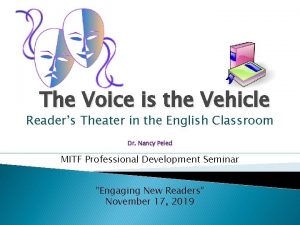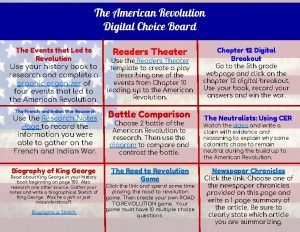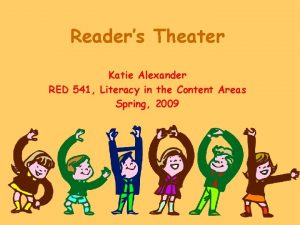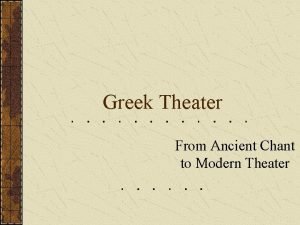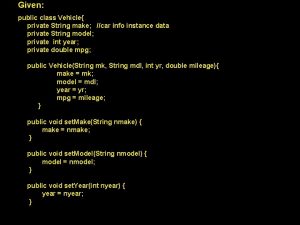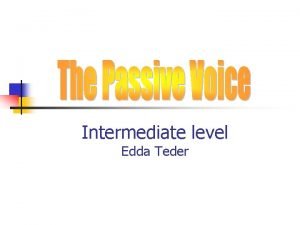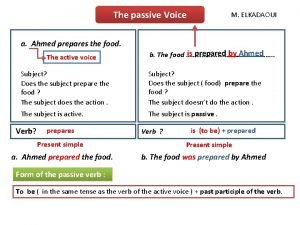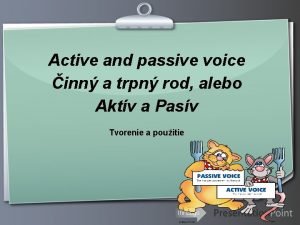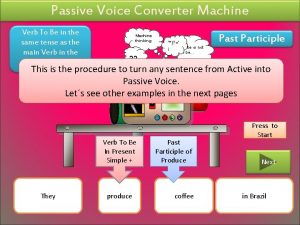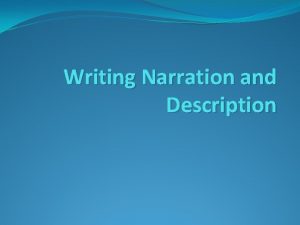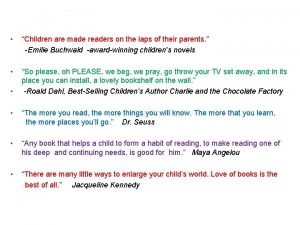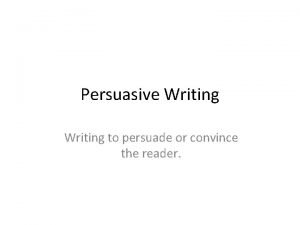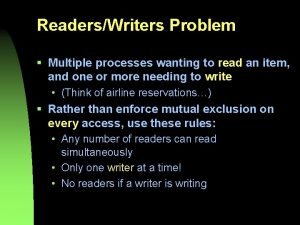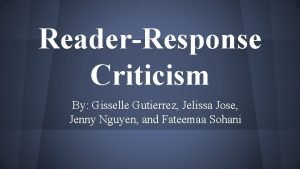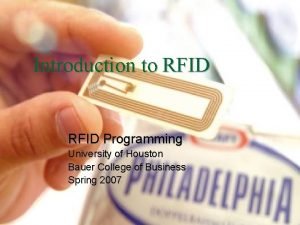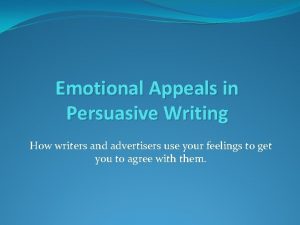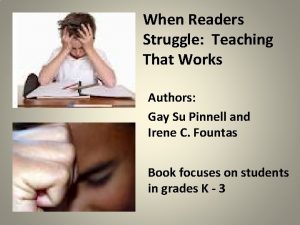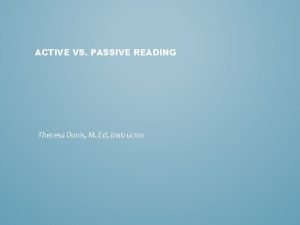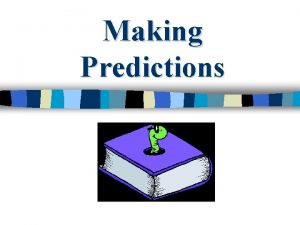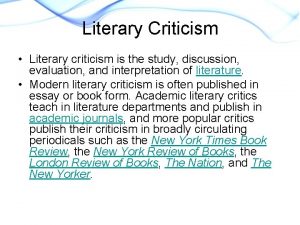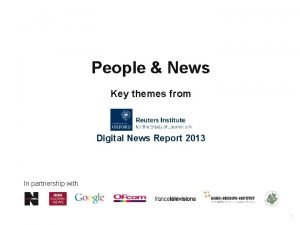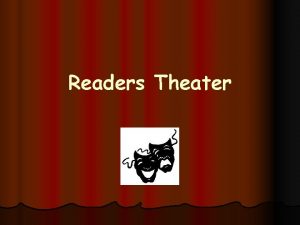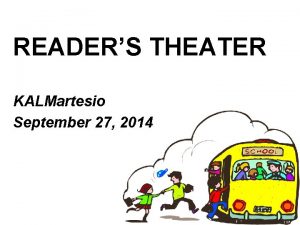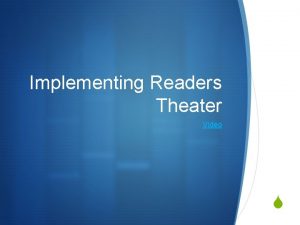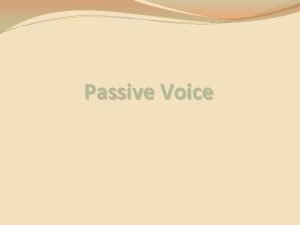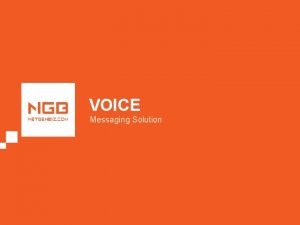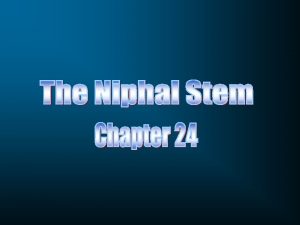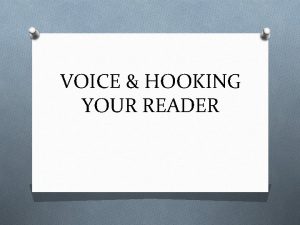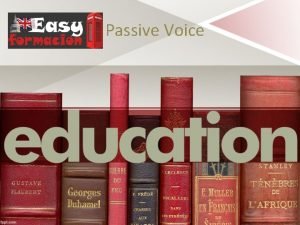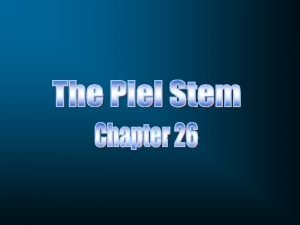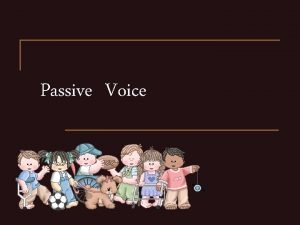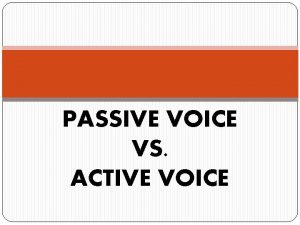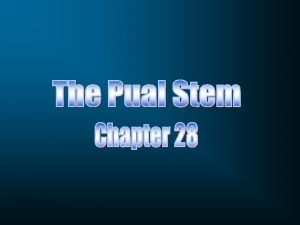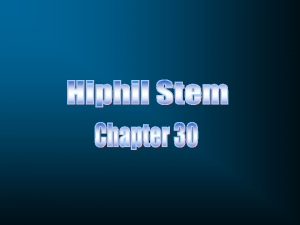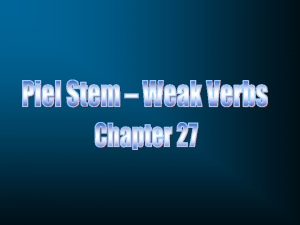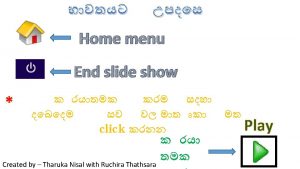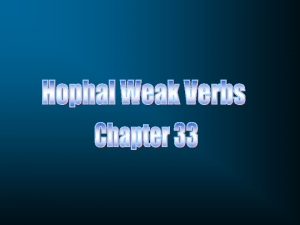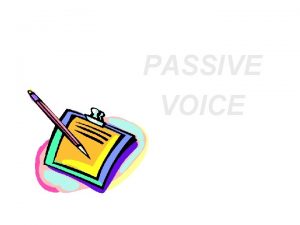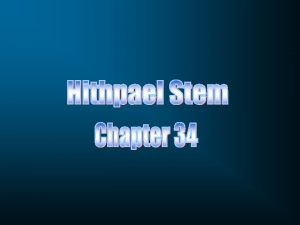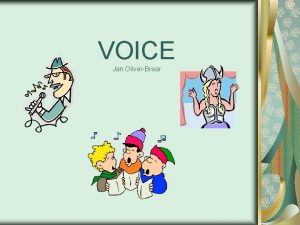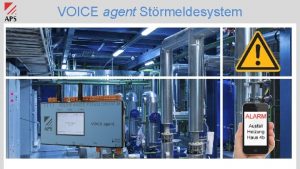The Voice is the Vehicle Readers Theater in

























- Slides: 25

The Voice is the Vehicle Reader’s Theater in the English Classroom Dr. Nancy Peled MITF Professional Development Seminar “Engaging New Readers” November 17, 2019

What is Reader’s Theater? Reader’s Theater is an interpretive reading activity in which readers use their voices to bring a text to life. Student teachers participating in RT at Oranim Academic College, 2015 Dr. Nancy Peled 2019

In Reader’s Theater the “performer’s” goal is to read a text aloud effectively, enabling the audience to visualize the action. Reader’s theater in the classroom is an instructional method. Student teachers reading from the play Anastasia, at Oranim Academic College, 2015. Dr. Nancy Peled, 2019

Why Use Reader’s Theater? Reader’s Theater is an appropriate and effective method for improving reading and oral fluency. “Fluency difficulties may be the key concern for upwards of 90% of children with significant problems in reading comprehension. ” 1997 American National Reading Panel Report Dr. Nancy Peled, 2019

What is Fluency? Fluency (automaticity) is performing any activity (including reading words) with no noticeable cognitive or mental effort. Fluency ~ in any activity~ is achieved through practice. So too, in reading, fluency is achieved through practice. Dr. Nancy Peled, 2019

What Is Reading Fluency? “One teacher observed, ‘I don’t know how to define fluency, but I know it when I hear it. ’” Martinez, Roser & Strecker, 2002. Fluency means reading text quickly, accurately, and with proper expression or prosody. This frees the reader’s attention to process meaning. The focus of reading instruction is for pupils to get to the meaning. Dr. Nancy Peled, 2019

Research Definitions Reading fluency is “a developmental process that refers to efficient, effective decoding skills that permit the reader to comprehend text. . Fluency is manifested in accurate, rapid, expressive oral reading and is applied during, and makes possible, silent-reading comprehension. ” Samuels & Farstrup, 2005. Prosody has been described as the “music” of speech and can be identified in the “enthusiasm, phrasing, emphasis, smoothness and pace” in oral reading. Groen, Veenendaal & Verhoeven, 2018. Dr. Nancy Peled, 2019

Using Voice Inflection (Prosody) to Convey Meaning Consider the implication of each statement: I I I I didn't didn't say say Nancy Nancy stole stole my my blue blue pen. Dr. Nancy Peled, 2019

The Importance of Reading Fluency “Our current thinking on reading fluency is that it is indeed an important factor when considering effective reading programs for students. Moreover, it may be even more of a concern for those students who experience difficulty in learning to read and comprehend what they read. ” Rasinski, Homan & Biggs, 2008. To gain meaning from text, students must read fluently. Dr. Nancy Peled, 2019

Reader’s Theater & Fluency Studies repeatedly demonstrate that Reader’s Theater is an instructional practice that develops fluency. (Garrett & O’Connor, 2010; Keehn, et al. , 2008; Young & Rasinski, 2009). Students improve comprehension using close reading techniques to fully understand vocabulary, characters, themes, and so on, before “performing” a text. *Students enjoy participating in Reader’s Theater!* Dr. Nancy Peled, 2019

Reader’s Theater & Reading Comprehension A Case Study involving fourth graders with comprehension skills but unable to actually read despite mediation. After using Reader’s Theater in the classroom: � in 10 weeks their reading level moved up by one year � in one year it jumped three grade levels The teacher called the transformation in their reading fluency "totally remarkable. " https: //www. scholastic. com/teachers/articles/teaching-content/power-readerx 2019 stheater / Dr. Nancy Peled, 2019

Reader’s Theater & Vocabulary Learning Research has shown that: � in order to learn vocabulary, students need to hear the pronunciation and practice saying the word aloud. (Ellis & Beaton, 1993; Fay and Cutler, 1977. ) � it is more effective to study words regularly over several short sessions than to study them for one or two longer sessions. (Hunt & Beglar, 1998. ) � fluency building activities recycle already known words in familiar grammatical and organizational patterns. (Nation, 1994. ) All of this occurs naturally while preparing Reader’s Theater! Dr. Nancy Peled, 2019

Implementing Reader’s Theater in the Classroom Dr. Nancy Peled, 2019

From Text to Script � Reader’s Theatre Play Title: � Based on the Book/Story: � Setting/Where does the story take place? : Name Cast of Characters Character Traits Read by Costumes/ Props Dr. Nancy Peled, 2018

Where the Wild Things Are Maurice Sendak The night Max wore his wolf suit AND made MISCHIEF of one kind another. Dr. Nancy Peled, 2019

Where the Wild Things Are Maurice Sendak Characters (6): NARRATOR / CHILD 1/ CHILD 2 / CHILD 3 / CHILD 4 MAX NARRATOR: THE NIGHT MAX WORE HIS WOLF SUIT CHILD 1: AND MADE MISCHIEF CHILD 2: OF ONE KIND CHILD 3: AND ANOTHER. NARRATOR: HIS MOTHER CALLED HIM CHILD 4: "WILD THING!" NARRATOR: AND MAX SAID: MAX: "I'LL EAT YOU UP!!" Dr. Nancy Peled, 2019

Assessing Possible points for attention: Student read the script with confidence and expression, made appropriate gestures and good eye contact. Student read smoothly and with correct phrasing to reflect the writer’s intended meaning. We heard and understood all the words. Dr. Nancy Peled, 2019

Advantages � Reader’s Theater promotes fluency because it demands repeated readings for a real reason- the performance. � It is an interactive activity with inherent motivation. � It increases self confidence in the readers. � It promotes overall reading growth. Dr. Nancy Peled, 2019

More Advantages � Reader's Theater meets the individual needs of many types of students: vstruggling readers. vstudents acquiring English. vaccelerated learners. � It promotes oral fluency. � It enhances vocabulary acquisition. Dr. Nancy Peled, 2019

Even More Advantages � Reader’s theater is an activity that is suitable for any age group, even those with minimal reading ability, from very young children to adults. � Practicing for the performance –that is, repeated reading- improves the ability to read connected text rapidly, smoothly, effortlessly, and automatically. Dr. Nancy Peled, 2019

The “Added Value” of Reader’s Theater in the Classroom � Provides a context for writing. � Expands vocabulary. � Promotes collaboration and attentive listening. � Offers a supportive context for peer assessment. � Can be integrated into other subjects. Dr. Nancy Peled, 2019

To Conclude Reader’s Theater in the classroom integrates reading, writing, speaking and listening in an authentic context. It makes reading come alive! Dr. Nancy Peled, 2019

Selected Bibliography Channell, J. (1988). Psycholinguistic considerations in the study of L 2 vocabulary acquisition. In R. Carter & M. Mc. Carthy (Eds. ), Vocabulary and Language Teaching. London: Longman. Clementi, L B. (2010). Readers theater: a motivating method to improve reading fluency. Phi Delta Kappan, 91 (5), 85 -88. Doherty J. , Coggeshall K. (2005). Reader's theater and storyboarding: Strategies that include and improve. Voices from the Middle, 12 (4) 37 -43. Groen, M. Veenendaal, N & Verhoeven, L. (2018). The role of prosody in reading comprehension: Evidence from poor comprehenders: Prosody and Reading Comprehension. Journal of Research in Reading, 42 (3), 1 -21. Hunt, A. & Beglar, D. (1998). “Current research and practice in teaching vocabulary” The Language Teacher, http: //jalt-publications. org/tlt/articles/1914 -current-research-and-practice-teaching-vocabulary Keehn, S. (2003. The effect of instruction and practice through readers theatre on young readers' oral reading fluency. Reading Research and Instruction, 42 (4), 40 -61. Loertscher D. V. ( 2009). More readers theater for middle school boys: adventures with mythical creatures. Teacher Librarian, 37 (10) 61; 84. Martinez, M. , Roser N. L. , & Strecker S. (1998 -1999). "I never thought I could be a star": a reader’s theatre ticket to fluency. The Reading Teacher, 52 (4), 326 -334. Mc. Kay, M. E. (2008). Readers Theatre—Take Another Look—It’s More Than Fluency Instruction LEARNing Landscape, 2 (1) 131 -144. Nation, I. S. P. (Ed. ). (1994). New Ways in Teaching Vocabulary. Alexandria, Virginia: TESOL, Inc. Ruggieri C. A. (2008). A chorus of thought: readers theater in the high school English class. English Journal; High School Edition , 97 (6), 118 -119. Young, C & Rasinski, T. (2009). Implementing readers theatre as an approach to classroom fluency instruction. The Reading Teacher, 63(1), 4– 13. Worthy, J & Prater, K. (2002). I thought about it all night: Readers theatre for reading fluency and motivation. The Reading Teacher, 56 (3), 294 -297. Dr. Nancy Peled, 2019

Sites with free RT scripts Aaron Shepherd has great resources: http: //www. aaronshep. com/rt/RTE. html Brian Smith shares ideas and scripts: https: //www. scholastic. com/teachers/blog-posts/briansmith/increasing-reading-fluency-readers-theater/ From Dr. Chase Young: http: //www. thebestclass. org/rtscripts. html A teacher resource site: http: //www. teachingheart. net/readerstheater. htm Promoting Spoken English in the 7 th Grade (MOE site) https: //sites. google. com/view/letstalk 7/home Dr. Nancy Peled, 2019

Some photos from past Oranim RT English Department Events
 Critical reading meaning
Critical reading meaning Where the wild things are readers theater
Where the wild things are readers theater Civil war readers theater
Civil war readers theater American revolution readers theater
American revolution readers theater ²www
²www Greek theater vs modern theater
Greek theater vs modern theater Private string java
Private string java Future perfect passive voice
Future perfect passive voice Passive patterns
Passive patterns Passive הסבר
Passive הסבר Passive voice rules chart
Passive voice rules chart Passive voice vs active voice
Passive voice vs active voice Active to passive voice converter
Active to passive voice converter Readers goal in narration
Readers goal in narration Language features of news item text
Language features of news item text Children are made readers on the laps of their parents
Children are made readers on the laps of their parents Writing to convince
Writing to convince Readers writers problem
Readers writers problem Reader response approach
Reader response approach Rifd readers houston
Rifd readers houston Appeal in persuasive writing
Appeal in persuasive writing When readers struggle
When readers struggle Passive reading
Passive reading Good readers make prediction by
Good readers make prediction by Readers response theory
Readers response theory Online readers
Online readers

